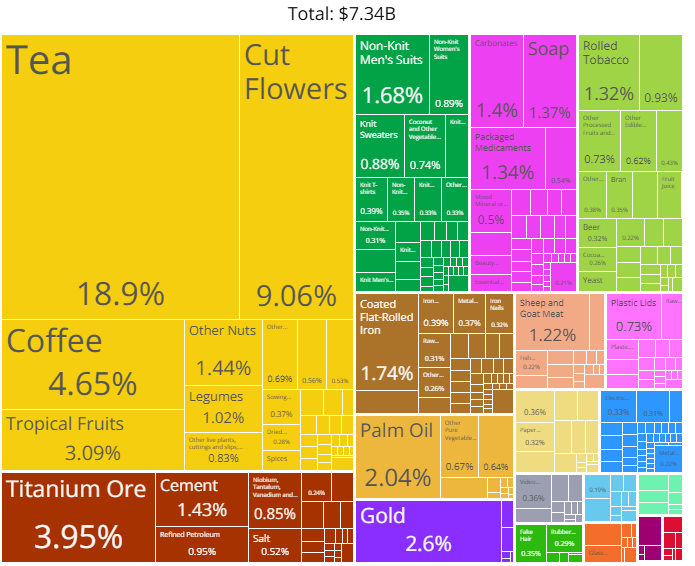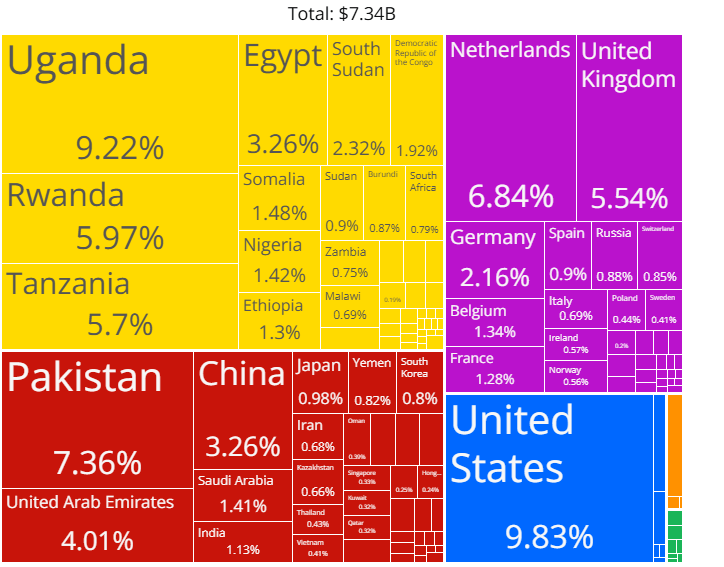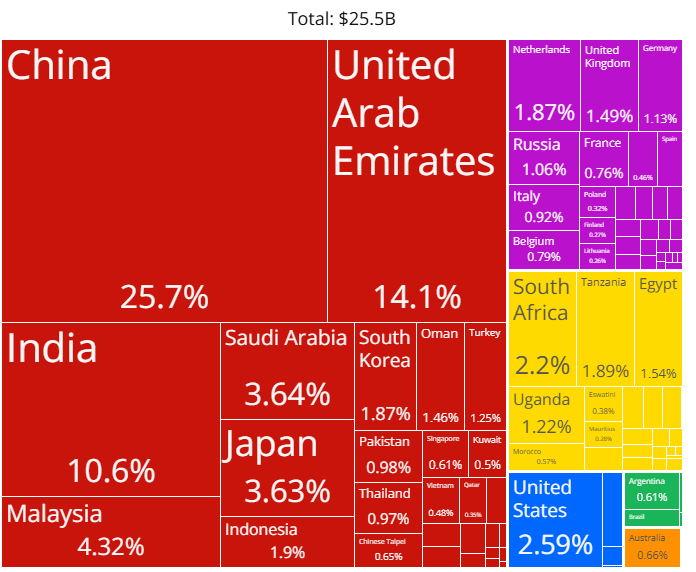Recently, I have become interested in how economies function and develop. To better understand this, I decided to take a closer look at Kenya’s economy, particularly regarding international trade. I discovered a useful visualisation website called the Observatory of Economic Complexity. Looking at Kenya’s 2022 data, our figures are as follows:
Exports

As you can see, most of our exports are agricultural commodities subsequently processed in other countries. The refined petroleum and palm oil we export are just passing through the country to our landlocked neighbours.
We have also been exporting titanium ore, again a raw material for many manufactured goods like paint pigment, food additives, sunscreen etc. In fact, did you know that 80% of our annual mineral revenue comes from this one mineral mined in Kwale? Unfortunately, we have mined it clean and Base Titanium, the mining company, is winding up operations (link). So in one fell stroke, we will lose about $290 from mineral exports. This is the curse of dependence on commodities.
Where Does Kenya Export?

The USA is our biggest customer, marginally edging out Uganda. Guess what we chiefly export to the USA? Clothes. 57% of our exports to the USA are clothes! We sell them new, high-quality clothes while we import second-hand clothes from them. Ironic, right? I wonder where we get the yarn, other materials, and clothing designs. Is it exclusively our local cotton and wool? Exclusively imported, or a mix of both?

Since tea is our biggest export and the Middle East and Arab countries are our biggest customers, it should be of great interest what happens there. What do we as a nation know about Pakistan? We sell them about half of our tea, $534M worth. Has a sitting Pakistan head of state ever made an official visit to Kenya or vice versa? Remember Arshad Sharif? The Pakistani journalist killed by Kenyan police in 2022? Did we take that assassination seriously or did we take the Pakistanis round and round in circles hoping the heat would die down?
Do we realize that stability in the Middle East means that they will have more money to spend on tea? In 2022, we exported well over $50 million worth of goat and sheep meat to the Middle East, and we have immense potential for much more. Why do we not take a keener interest in their affairs and our relationship with them? We focus so much on the West, but really, the African, Asian, and Middle Eastern countries are our best customers.
How about our neighbours? East Africa and the rest of Africa take up 40% of our exports! Their prosperity is our prosperity. We should be driving the integration of East and Central Africa to stimulate trade and the movement of people. But what do we do? Our president, Dr Ruto, in his most recent international relations blunder, angered the Congolese by calling the French president to help resolve the M23 issue in Eastern Congo, a move the locals didn’t take too kindly and they reacted by trashing our high commission in Kinshasa. I wonder how far this will set back our relations given how emotive the M23 issue is in the DRC.
Imports
.png)
Our Suppliers

Kenya chiefly imports finished products except for palm oil which we import from the South Asian countries of Indonesia and Malaysia. But did you know that the palm tree is native to Africa? This plant has made billionaires in Asia, South America and Europe. Why is the palm oil business lucrative? Palm oil is an important ingredient in many finished products, from cooking oils to soap and biofuels. We should be cultivating this crop and exporting palm oil ourselves. Thankfully, we have realised this and BIDCO, put up a plant in Uganda and they are planning to do the same in Kenya after their success in Uganda.
I wonder why we import so much wheat, $576M worth of wheat in fact and we have thousands of hectares of idle land.
As for cars, we let our only homegrown car manufacturer, Mobius Motors die rather than prop it up and boost our manufacturing sector. I wonder what would have happened to the company had the government ordered 111 police cars from Mobius rather than VW.
We also imported $135.1 million worth of milk and concentrated milk. We are not taking our dairy industry seriously, probably because there is everything for the people to gain and nothing for the politicians to grab. Kenya’s annual milk demand is about 8 billion litres, compared to local production of 4.6 billion litres largely fueled by small-scale farmers. The demand exists, but the sector has been neglected, and it is largely a loss-making venture for small-scale farmers. What if we upgraded our dairy industry and superseded our current demand? We could then diversify into making ghee, butter and cheese thus eliminating the need for margarine and palm oil. This one move could reduce our import bill, and increase local production and exports while improving our health as a nation. Imagine that.
Our economy is relatively unsophisticated. We grow things, harvest them, and then sell them. There is little value addition or processing, which denies us much-needed revenue and development.
Why do we supply substandard seeds and fertilizers to maize farmers and expect them to feed the nation? Why do we not have a vibrant irrigation culture in the country? We set up the Galana Kulalu irrigation project back in 2014 then proceeded to bungle the project in the most incompetent fashion possible. And now we want to resuscitate this monster. We have the land, water and expertise but not the political will.
Why do we think animal husbandry is building slaughterhouses everywhere? County governments are falling over themselves to build abattoirs. What value do slaughterhouses add to meat? Why do we not invest in extension services, water harvesting, pasture management, and fattening centres/ feed lots? Why does our government think that buildings, railways, and such infrastructure equate to economic development?
This foolish policy of ‘if we build they will come’ is just plain stupid trickle-down economics that does not work! Cue Konza City, a laughable attempt to recreate Silicon Valley in Kenya by building skyscrapers and airports rather than building local human capital and internet infrastructure. Silicon Valley was built around Stanford University on a foundation of cutting-edge research and application.
Our government also focuses intensely on pleasing foreign investors and tourists rather than empowering locals who will propel the economy upwards from the ground up. How many wealthy countries became so through foreign investors? Some countries did start this way but eventually, the locals absorbed whatever knowledge they imported from foreigners and then applied it in their way until eventually, they were able to create and innovate on their own. How much do foreign investors bring in to warrant such attention? If the same laser focus was turned on agriculture, value addition, local innovations, manufacturing, the service economy and most importantly, the citizens themselves, it would have a lasting multiplier effect on the economy.
We shall never get wealthy exporting raw materials.
According to the statistics on Gapminder, in the last two centuries, the share of income from agriculture, forestry and fishing has been dropping steadily and it is now at 5% of global income. No country has become rich by relying on these traditional industries for their income, instead, manufacturing, processing raw materials, complex services and natural resources like oil are the main propellers to wealth. Now, this does not mean that you reduce agricultural output, no, it means you drive up other sectors exponentially such that agriculture even though it is growing, is dwarfed by these more complex industries.
In many low and mid-income countries, a substantial percentage of tax revenue is collected from import taxes and the small pool of formal employees since the majority of the economy is informal and thus difficult to tax. The best way out of this is to focus on developing the informal sector into a large formal sector so that the tax burden is more evenly spread out rather than shouldered by just a few. Failure to recognize and remedy this leads to higher and higher taxation on fewer and fewer citizens and businesses as the government struggles to raise revenue to run the country. Taxes and interest rates inevitably rise and a money-hungry, inefficient government sucks cash and private debt from the economy leading to depleted savings, lower money velocity, lower investment and ironically, lower income to tax! New bills to increase tax or device new taxes will come up in a bid to raise the tax revenue but this is a reinforcing loop that will drive an economy to the ground if not checked early enough. Sound familiar?